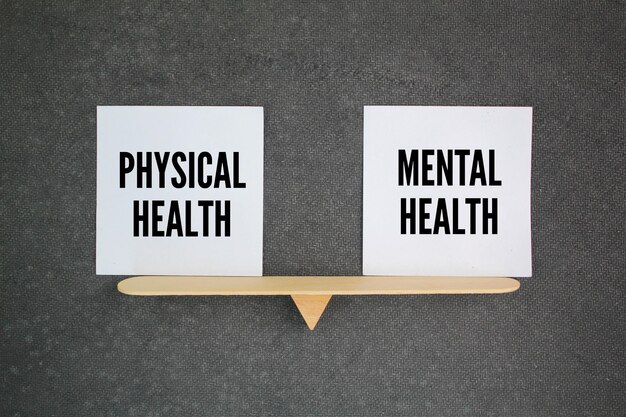Mental Health Parity Rules 2025: What You Need to Know

In 2025, new mental health parity rules aim to ensure insurance plans provide equal coverage for mental health and substance use disorder (SUD) services, addressing disparities with physical health benefits.
Navigating the complexities of health insurance can be daunting, especially when it comes to mental health coverage. In 2025, significant changes are coming into effect with new mental health parity rules. Here’s what you need to know about the new mental health parity rules for insurance plans in 2025, ensuring you or your loved ones receive the care you deserve.
Understanding Mental Health Parity: A Foundation
Mental health parity is a principle that ensures insurance coverage for mental health and substance use disorder (SUD) services is no more restrictive than coverage for other medical or surgical procedures. This means comparable co-pays, deductibles, and limitations on treatment.
The Mental Health Parity and Addiction Equity Act (MHPAEA)
The Mental Health Parity and Addiction Equity Act (MHPAEA) of 2008 was a landmark piece of legislation that laid the groundwork for parity. It required that health plans offering mental health and substance use disorder benefits provide coverage comparable to medical and surgical benefits. This aimed to eliminate discriminatory practices that limited access to mental healthcare.
Key Provisions of MHPAEA
- Financial Requirements: Prohibits higher co-pays, deductibles, and out-of-pocket maximums for mental health and SUD services compared to medical/surgical benefits.
- Treatment Limitations: Ensures that treatment limitations, such as visit limits or stricter pre-authorization requirements, are no more restrictive than those applied to medical/surgical benefits.
- Scope of Benefits: Requires coverage for mental health and SUD services to include a wide range of treatments and services, comparable to what is offered for physical health conditions.
While MHPAEA was a significant step forward, enforcement and interpretation have been ongoing challenges, leading to the new rules in 2025 to address these gaps.
In summary, mental health parity seeks to eliminate discrimination in insurance coverage, ensuring that individuals have equal access to mental health and substance use disorder services. MHPAEA set the stage, and the new rules in 2025 build upon this foundation to create a more equitable and accessible healthcare system.
What’s Changing in 2025: Key Updates
The year 2025 brings significant updates to mental health parity rules, strengthening existing protections and addressing previous shortcomings. These changes aim to provide greater clarity, improve enforcement, and expand access to mental healthcare.

Enhanced Enforcement Mechanisms
One of the critical updates is the strengthening of enforcement mechanisms. The Department of Labor and other regulatory agencies will have increased authority to investigate and penalize insurance plans that violate parity laws. This includes more rigorous audits and compliance checks.
Expanded Definition of Medical Necessity
The definition of medical necessity is being broadened to include a wider range of mental health and SUD services. This ensures that insurance plans cannot deny coverage for treatments deemed necessary by qualified healthcare professionals, even if those treatments are not traditionally covered.
Increased Transparency Requirements
- Coverage Details: Insurance plans will be required to provide detailed information about their mental health and SUD coverage policies, including specific criteria used to determine medical necessity and treatment limitations.
- Denial Explanations: When coverage is denied, plans must provide clear and understandable explanations, outlining the reasons for the denial and the steps policyholders can take to appeal the decision.
- Data Reporting: Plans will need to report data on their mental health and SUD coverage, allowing regulators to identify potential disparities and monitor compliance with parity laws.
In 2025, the updated mental health parity rules are designed to provide more consistent and equitable coverage for mental health and SUD services. These changes aim to address existing gaps, improve enforcement, and promote greater transparency, ultimately benefiting individuals seeking mental healthcare.
How the New Rules Impact Insurance Plans
The new mental health parity rules in 2025 will significantly impact how insurance plans operate and provide coverage for mental health and substance use disorder services. Here’s a breakdown of the key changes and their implications for insurance plans.
Compliance Requirements
Insurance plans will face stricter compliance requirements to ensure they are meeting the standards set by the updated parity laws. This includes conducting internal audits to identify potential disparities in coverage and implementing corrective actions.

Cost Implications
While parity aims to provide equitable coverage, insurance plans may experience increased costs associated with mental health and SUD services. However, these costs are expected to be offset by long-term benefits, such as improved health outcomes and reduced healthcare spending in other areas.
Changes to Provider Networks
- Network Adequacy: Insurance plans will need to ensure they have an adequate network of mental health and SUD providers to meet the needs of their policyholders. This may require expanding their provider networks and contracting with additional specialists.
- Reimbursement Rates: Plans may need to adjust their reimbursement rates for mental health and SUD services to attract and retain qualified providers, ensuring that they are compensated fairly for their services.
- Telehealth: Given the increasing popularity and accessibility of telehealth, insurance plans will likely need to expand their coverage of telehealth services for mental health and SUD treatment.
In summary, the new mental health parity rules require insurance plans to prioritize compliance, manage costs effectively, and ensure adequate access to mental health and SUD providers. These changes are designed to create a more equitable and comprehensive healthcare system for all.
What the Changes Mean for Individuals and Families
The updates to mental health parity rules in 2025 have profound implications for individuals and families seeking mental health and substance use disorder services. These changes are designed to increase access, improve coverage, and reduce the financial burden of mental healthcare.
Increased Access to Care
With expanded definitions of medical necessity and enhanced enforcement, individuals will find it easier to access the mental health and SUD services they need. Insurance plans will be less likely to deny coverage for essential treatments, ensuring that individuals receive timely and appropriate care.
Reduced Financial Burden
By eliminating discriminatory practices in co-pays, deductibles, and treatment limitations, the new parity rules help reduce the financial burden associated with mental healthcare. This makes treatment more affordable and accessible, particularly for those who may have previously been unable to afford it.
Greater Transparency and Accountability
- Informed Decisions: Increased transparency requirements mean that individuals will have better access to information about their mental health and SUD coverage. This allows them to make more informed decisions about their healthcare options.
- Appeals Process: When coverage is denied, individuals will receive clear explanations and guidance on how to appeal the decision. This empowers them to advocate for their rights and challenge unfair denials.
- Support Resources: Many organizations and advocacy groups offer resources and support to individuals navigating mental health parity laws. These resources can provide valuable assistance and guidance.
Ultimately, the changes to mental health parity rules in 2025 are intended to create a more equitable and accessible healthcare system for individuals and families. By increasing access, reducing financial burdens, and promoting transparency, these rules empower individuals to prioritize their mental health and seek the care they need without facing unnecessary barriers.
Navigating Insurance Coverage in 2025: Tips and Strategies
Navigating health insurance coverage, especially when it comes to mental health, can still be challenging even with the new parity rules in 2025. Here are some practical tips and strategies to help you understand your coverage and access the care you need.
Understand Your Policy
Take the time to thoroughly review your insurance policy and understand the details of your mental health and SUD coverage. Pay attention to co-pays, deductibles, treatment limitations, and network requirements.
Know Your Rights
Familiarize yourself with your rights under mental health parity laws. Understand that your insurance plan must provide coverage for mental health and SUD services that is comparable to coverage for medical and surgical benefits.
Document Everything
- Keep Records: Maintain detailed records of all your healthcare interactions, including appointments, treatments, and communications with your insurance company.
- Track Expenses: Keep track of all out-of-pocket expenses related to your mental healthcare, such as co-pays, deductibles, and prescription costs.
- Save Correspondence: Save all correspondence with your insurance company, including emails, letters, and claim denials.
Seek Assistance When Needed
If you encounter difficulties navigating your insurance coverage or accessing mental healthcare, don’t hesitate to seek assistance from advocacy groups, patient support organizations, or legal professionals. They can provide valuable guidance and support.
By understanding your policy, knowing your rights, and seeking assistance when needed, you can successfully navigate insurance coverage in 2025 and access the mental healthcare you deserve. These strategies empower you to take control of your healthcare journey and advocate for your needs effectively.
The Future of Mental Health Parity
Looking ahead, the future of mental health parity holds both promise and challenges. As awareness of mental health issues grows and the demand for accessible, equitable care increases, ongoing efforts are needed to strengthen parity laws and address emerging issues.
Technological Advancements
Technological advancements, such as telehealth and digital mental health tools, are transforming the landscape of mental healthcare. These innovations have the potential to increase access to care, particularly in underserved areas.
Policy and Advocacy
- Legislative Updates: Ongoing policy and advocacy efforts are essential to strengthen mental health parity laws and address emerging issues. This includes advocating for increased funding for mental health services and improved enforcement of parity laws.
- Public Awareness: Raising public awareness about mental health parity and reducing stigma are critical to promoting access to care and ensuring that individuals receive the support they need.
- Community Collaboration: Collaboration among healthcare providers, policymakers, advocacy groups, and community organizations is essential to create a comprehensive and equitable mental healthcare system.
The future of mental health parity depends on our collective commitment to ensuring that mental health is treated with the same importance as physical health. By embracing technological advancements, advocating for strong policies, and fostering community collaboration, we can create a healthcare system that prioritizes mental wellness and provides equitable access to care for all.
| Key Point | Brief Description |
|---|---|
| ⚖️ Enhanced Enforcement | Stricter audits and penalties for non-compliant insurance plans. |
| ✅ Medical Necessity | Broader definition ensures more treatments are covered. |
| 📢 Transparency | Insurers must provide detailed coverage info and denial explanations. |
| 🧑⚖️ Individual Impact | Easier access to care, reduced costs, and better information. |
Frequently Asked Questions
▼
Mental health parity ensures that insurance coverage for mental health and substance use disorder services is comparable to coverage for medical and surgical benefits, eliminating discriminatory practices.
▼
The Mental Health Parity and Addiction Equity Act (MHPAEA) requires health plans offering mental health benefits to provide coverage comparable to medical/surgical benefits, addressing disparities like higher co-pays.
▼
In 2025, expect enhanced enforcement, expanded definitions of medical necessity, and increased transparency requirements, strengthening parity laws and improving access to mental healthcare.
▼
Insurance plans will face stricter compliance requirements, potential cost implications, and will need to adapt their provider networks to ensure adequate coverage for mental health services.
▼
Individuals should understand their policies, know their rights, document healthcare interactions and expenses, and seek assistance from advocacy groups or legal professionals when needed.
Conclusion
The new mental health parity rules in 2025 represent a significant step forward in ensuring equitable access to mental healthcare. By understanding these changes, individuals and families can better navigate their insurance coverage and advocate for the services they need, contributing to a healthier and more supportive society.
